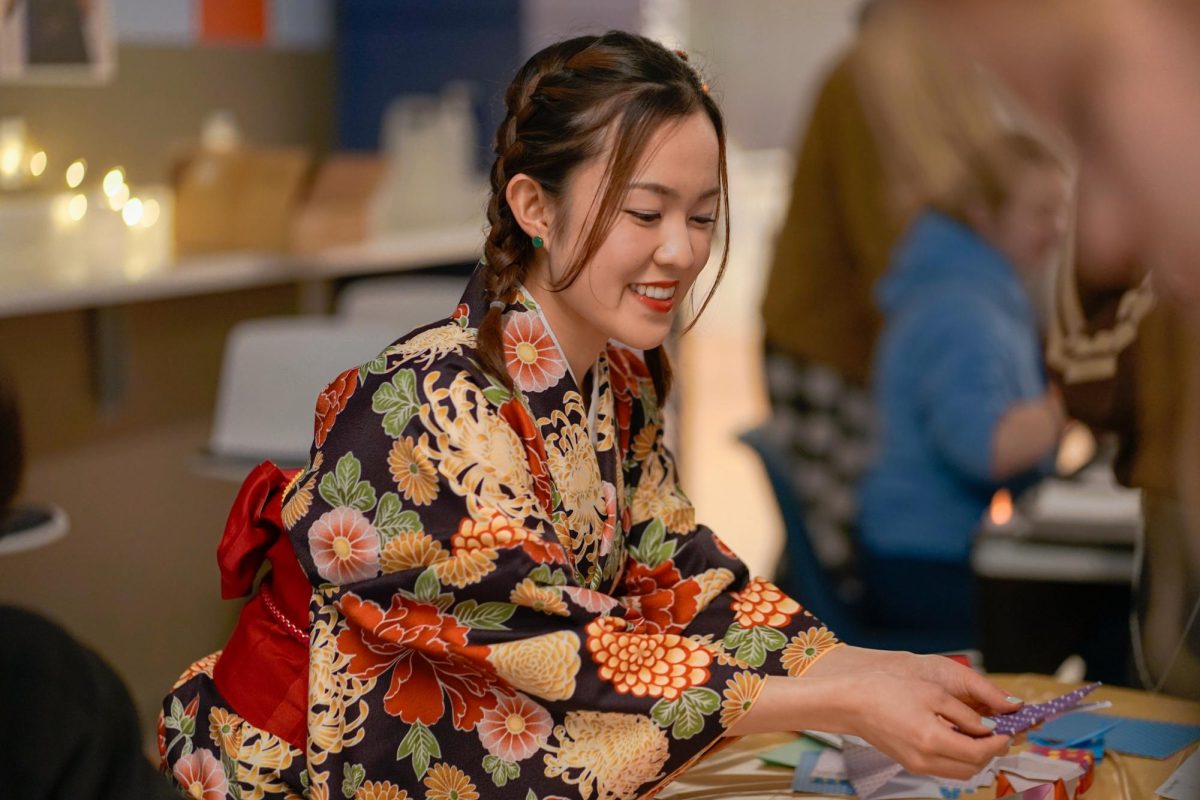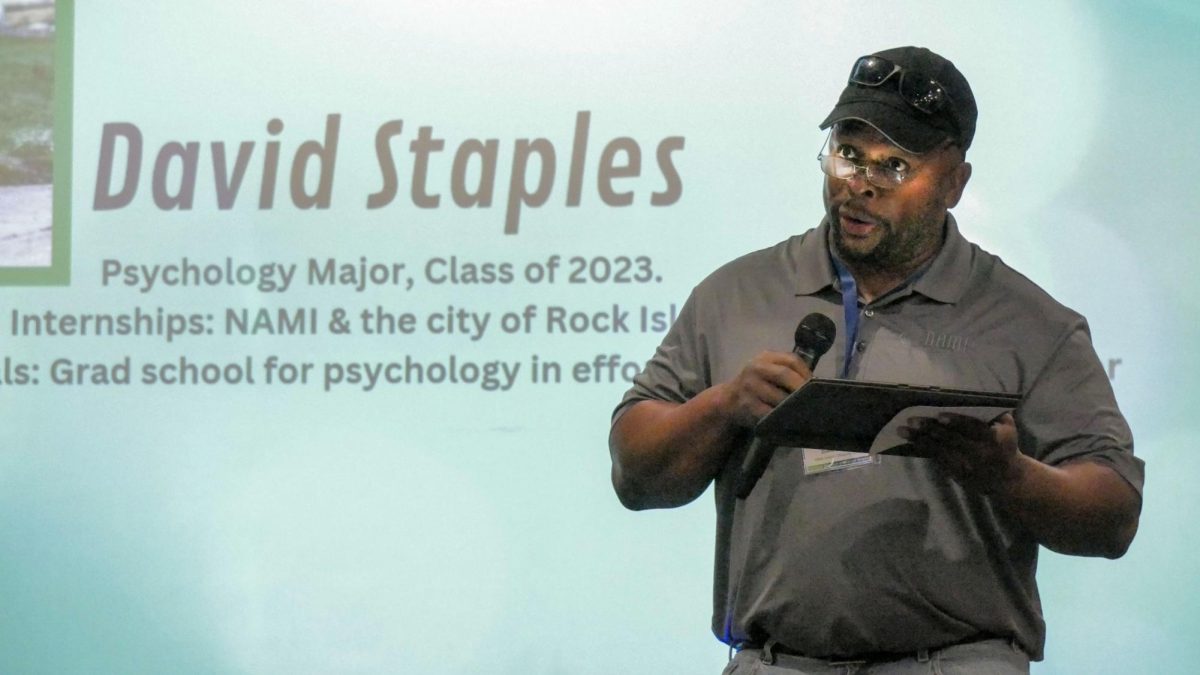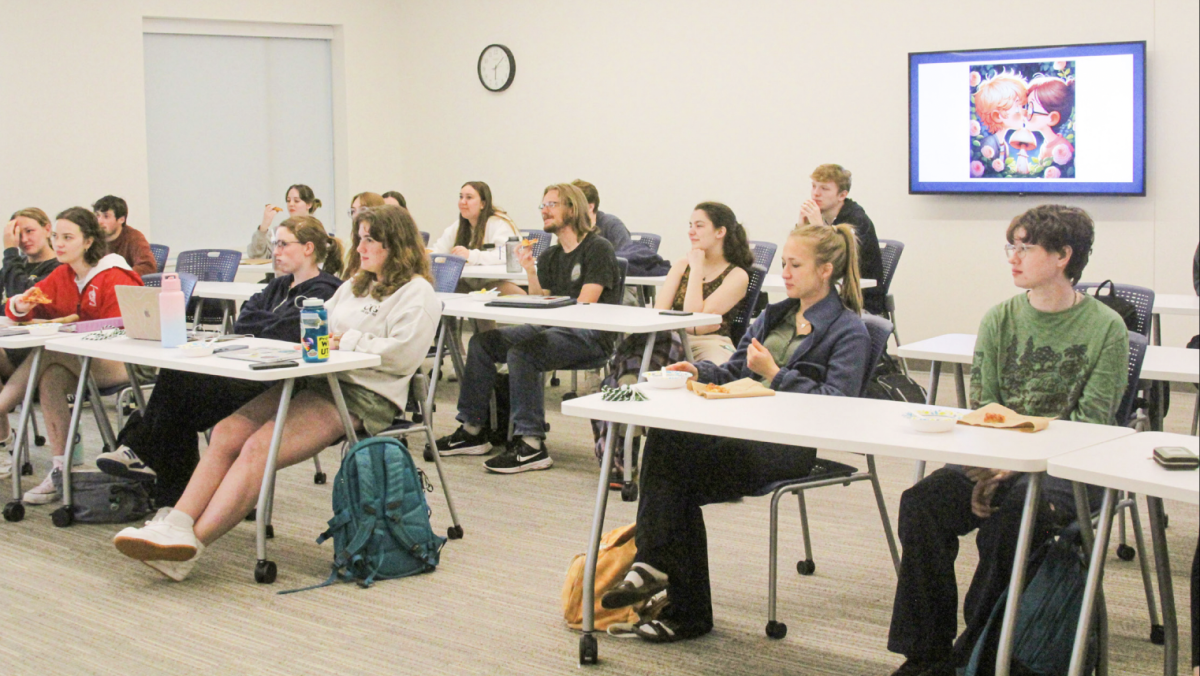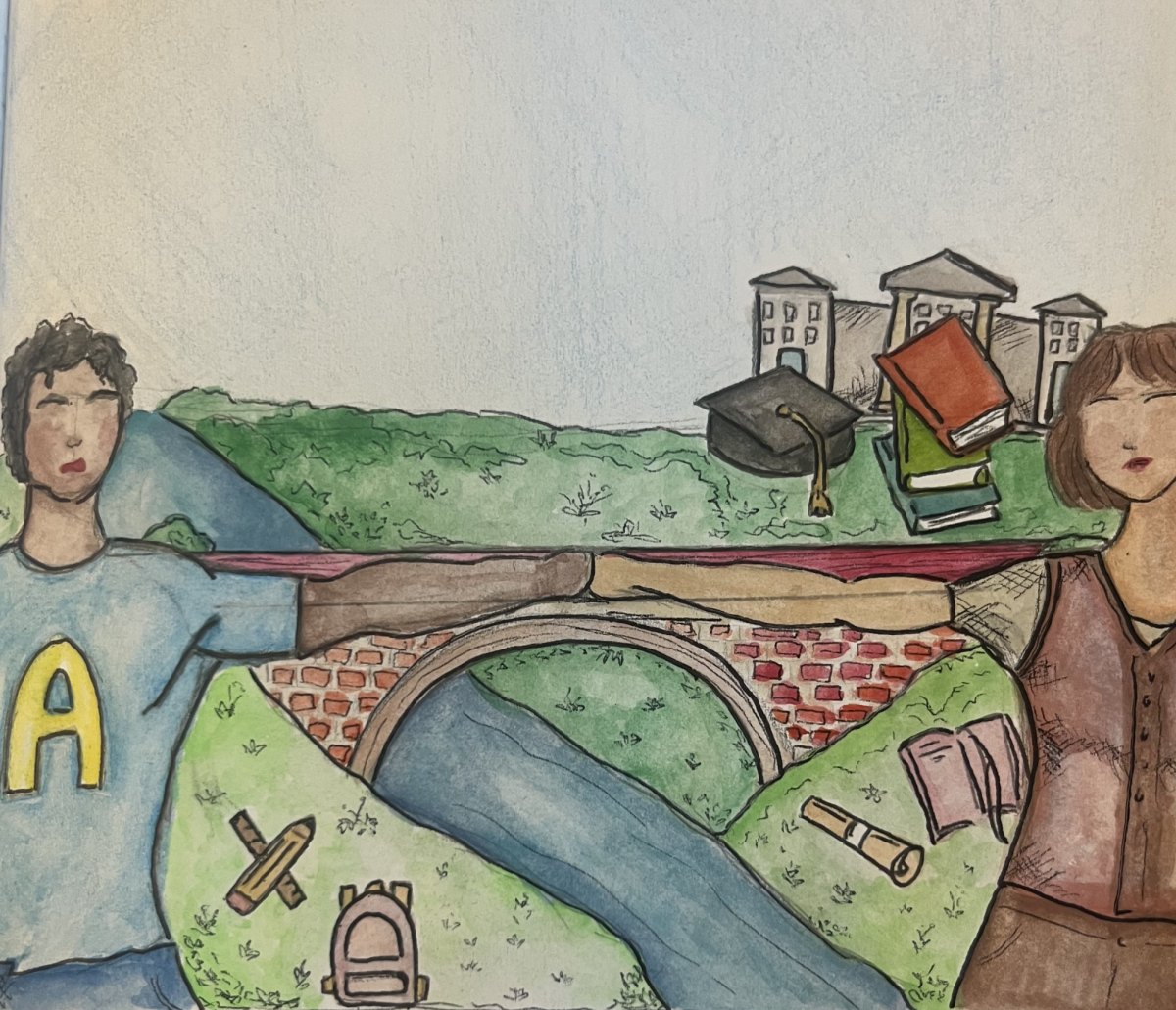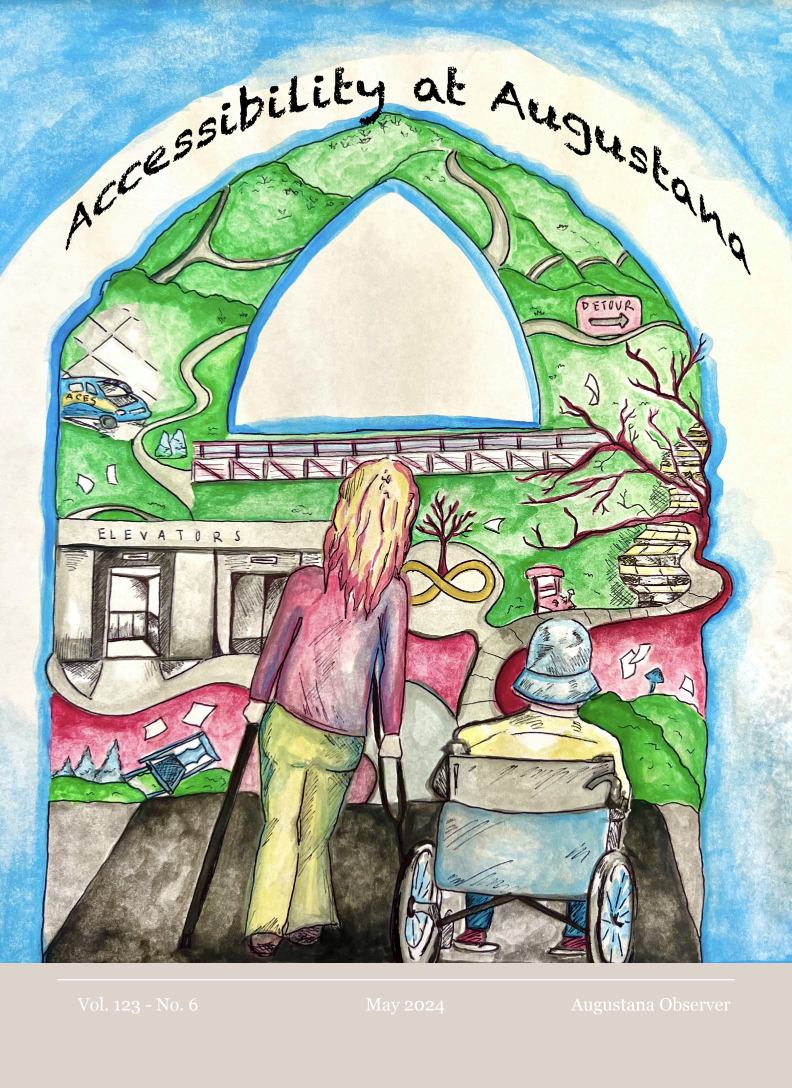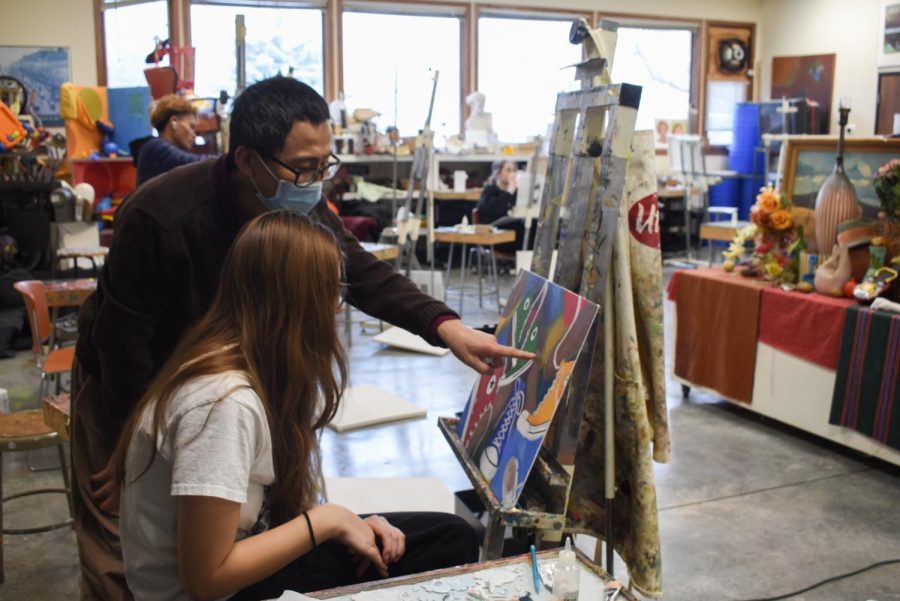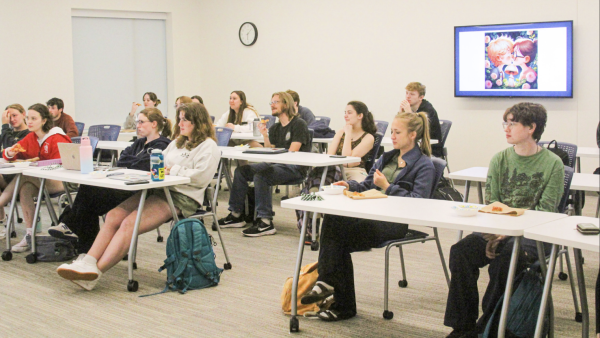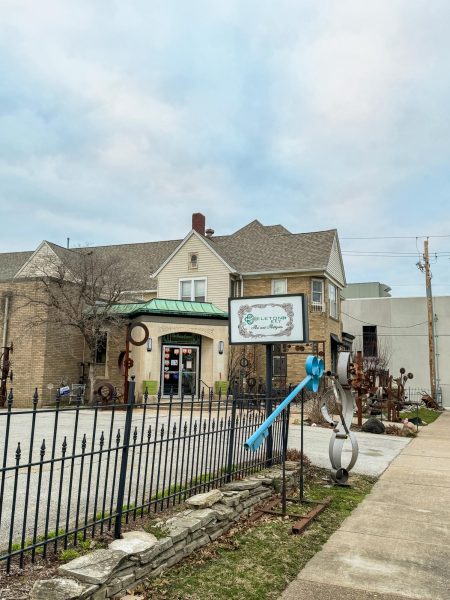Professor Peter Xiao and the color green
Peter Xiao speaks with a student during a painting class in Abbey Studios.
November 26, 2022
While most kindergartners were busy playing with blocks and running around the playground, Augustana art professor Peter Xiao remembers pacing through the green of his backyard, hands clasped behind his back “like grownups,” wondering what he would grow up to be. The thought of painting had yet to enter his mind.
“The first moment I can associate with [being interested in the arts] was kindergarten,” Xiao said. “I was put in a position to do acting, and I knew even back then that it was no good. I remember after that … wondering whether I wanted to grow up to be a poet or an artist or something.”
A year or two later a young Xiao and his mother stopped at the railway station in Beijing. While there, Xiao’s mother wanted him to draw the Soviet Union style building. His art drew the attention of onlookers.
“I remember she had to go and get an eraser for me,” Xiao said. “And then there was a crowd around me.”
This began what would eventually become Xiao’s art career. Decades later, Xiao finds himself a prolific painter as well as a long-time professor of art at Augustana College.
“I was lucky enough to land a job, and the best one was a full-time tenure track at Augustana,” Xiao said. “When I was first interviewed by Tom Tredway, he was talking 70 miles an hour and I had no idea what he was saying, so I just said yes.”
Professor Megan Quinn was part of the committee that hired Xiao. Out of hundreds of applicants, Xiao stood out because of his kindness and overall demeanor.
“I think we might have had 300 applicants. It was ridiculous,” Quinn said. “He just rose to the top. He wrote this charming letter about visiting and meeting us and how much he would enjoy the job. He was just incredibly thoughtful and patient, you could tell.”
Many describe Xiao’s character as kind, passionate and reserved. He proves his passion for art and teaching in the way that he interacts with those around him.
“He’s really helpful,” Quinn said. “If he sees any articles about things he knows you’re interested in he collects them; he goes to museums and brings you the show profiles. He’s really generous.”
Xiao’s generosity extends beyond his interactions with his colleagues. He strives to help his students improve and feel good about themselves as artists. Xiao mentioned that he focuses on positivity especially while critiquing students’ work.
“I keep in mind that Fredrico Fellini, the filmmaker, would say that you should never discourage a young artist,” Xiao said. “I break down my criteria for assessing things into four parts, and at least half of the parts are focused on the effort made.”
Senior studio art major Carley Anderson said that she believes Xiao always means well. Although students may not always agree with his critiques, they are delivered in a kind and professional way that makes it hard to be mad.
“He’s a little soft spoken at times, but he’s not shy about sharing his opinion,” Anderson said. “He delivers his advice in a very kind manner. He’s so knowledgeable and some of the things that he applies to his art [are things] I would never consider myself as an artist.”
Professor Rowen Schussheim-Anderson had similar sentiments. Even after working alongside Xiao for over thirty years, Schussheim-Anderson has very rarely seen him angry.
“He might have an issue about something, but he is never really angry and he always seems to take things in stride,” Schussheim-Anderson said. “Even though he has very good and strong ideas he’s very collegial. He’s very willing to hear more than one side of things, and he’s very willing to listen.”
When Xiao offers his opinion in class, many students decide to take his advice. Being an artist himself, Xiao’s critiques often hold more value than students realize. Xiao’s art has been displayed in a variety of art shows, including one that sold out during his time in college.
“He is prolific,” Quinn said. “He’s really amazing in terms of how many shows he has, and [he’s] really humble about it.”
Xiao’s art is impressive in ways beyond those that are obvious to someone who may be viewing it from the outside. His use of the color green, for example, is something that many artists would never even consider. However, it has the capability to make or break a piece.
“He is a genius and very interesting when it comes to color and color theory,” Anderson said. “I don’t know how he does it, but he just knows how to use the color green. He gets very excited when he sees other students using color.”
Many young artists struggle to incorporate the color green into their work because of its unusual ability to be both warm and cool. Xiao tends to use green in many aspects of his art, including skin colors, and he seems to try to pass on his unique way of seeing and creating art to his students.
Along with his use of the color green and color in general, Xiao teaches his students important lessons about how rewarding it can be to be engaged in a piece.
“I think his first thing is getting across his passion about art and his strong sense of producing good, hard work to students,” Schussheim-Anderson said.
Interestingly enough, Xiao’s steadfast belief in his students’ abilities did not extend to himself during his own time as an undergraduate student. As a young adult, Xiao believed that he would grow up to be a poet or a translator like his parents. He had always expected to pursue a career in English and follow in the footsteps of his father.
“My parents were translators of Western literature –my mother was mostly Japanese literature and my father mostly English,” Xiao said. “Later on, with the help of other writers, [my father] became an editor, went to university and studied journalism.”
In the late 1960s, Xiao’s father became involved in the Cultural Revolution in China. During that time, he began to teach Xiao English due to the “safe” nature of the subject. With his reputation restored after the revolution, Xiao’s father began to pursue more opportunities.
“In my sophomore year of college … [my father] was selected to represent Chinese writers and come to the University of Iowa for the International Writers Program,” Xiao said. “The year after, I would come [to the United States] as a transfer student from Beijing.”
Xiao’s father’s opportunity ended up allowing Xiao himself to discover his real passion for art. Through connections made by his father, Xiao was able to study at Coe College in Cedar Rapids, Iowa before traveling abroad for a while.
“The founder of the International Writers Program … went to Coe college,” Xiao said. “He only needed to make a phone call and then the college was busy making a scholarship for me.”
When Xiao traveled abroad during his third year of college, he studied in many different countries. His journey into art started when he took an art history class in Florence, Italy, which he described as “just a dream.”
Xiao began thinking about the possibility of pursuing art as a career, and he stayed abroad to further explore instead of immediately returning to the United States once the program ended. When he traveled to Amsterdam, he made up his mind.
“I visited Amsterdam after my Italian sojourn,” Xiao said. “That trip really made me feel like I’m going to be an artist.”
Xiao’s art eventually brought him back to the United States where he attended the Tyler School of Art near Philadelphia, Pennsylvania for graduate school. Shortly after he finished graduate school, he began his career as a professor at Augustana.
His humble personality led to a lack of personal narrative in his art to begin with which has changed throughout his time at Augustana.
“At first he was not very open about sharing his background in terms of his art, but lately he has been sharing that,” Quinn said. “I’m glad he’s sharing that more.”
After many decades as an art professor at Augustana, Xiao has become more open about his background and has consistently made good impressions on those he interacts with.
“He’s an upbeat person and just a good colleague and a friend,” Schussheim-Anderson said.
Xiao’s manner makes for a fun, engaging experience when students take his classes. His focus on giving students the opportunity to achieve their goals shows even when they interact with him outside of class.
“His knowledge is so contagious. His attitude is incredible,” Anderson said. “Even if you don’t consider yourself a good artist, he will point out the good qualities of your work.”
A phrase that Xiao heard from his neighbor as a child has stuck with him to the point of becoming a philosophy, and he uses it in his teaching as well as in interactions with fellow artists.
“One [saying] that always stayed with me was something about art being sacred,” Xiao said. “Therefore, there’s no shyness or self consciousness that needs to be involved. Basically, that’s the highest calling that one could have.”






